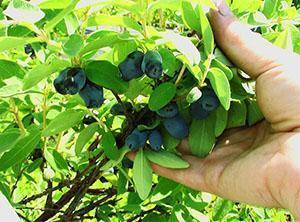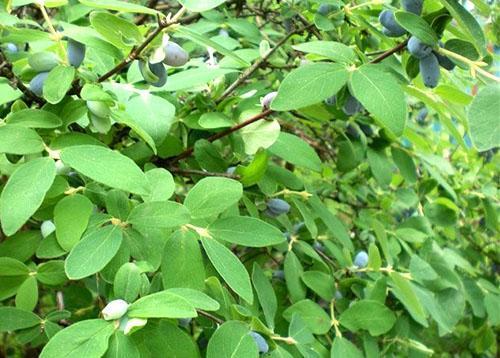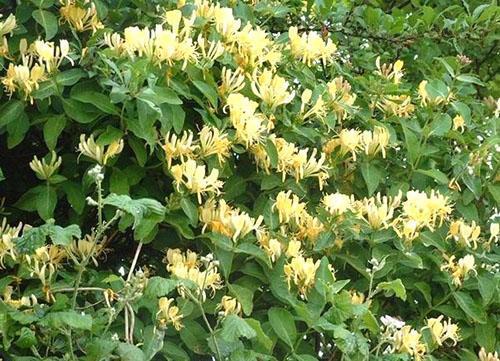Honeysuckle varieties for the Moscow region
 Honeysuckle is an adornment for any garden. Its flowers have an intoxicating aroma, and the berries have an unusual taste. The popularity of the plant grows every year and more and more often low bushes with small bluish-blue fruits appear in the gardens of the Moscow region. Honeysuckle is appreciated for its easy care, the ability to easily endure harsh winters and produce a stable harvest. The shrub is very hardy and resistant to recurrent frost during flowering. At a temperature of -5 ° C, the inflorescences remain on the bush and bear fruit well. This bush is a record holder! Just imagine that a plant is capable of bearing fruit up to a "respectable" age. Small berries can be plucked from a bush that has long been over 30 years old. Impressive?
Honeysuckle is an adornment for any garden. Its flowers have an intoxicating aroma, and the berries have an unusual taste. The popularity of the plant grows every year and more and more often low bushes with small bluish-blue fruits appear in the gardens of the Moscow region. Honeysuckle is appreciated for its easy care, the ability to easily endure harsh winters and produce a stable harvest. The shrub is very hardy and resistant to recurrent frost during flowering. At a temperature of -5 ° C, the inflorescences remain on the bush and bear fruit well. This bush is a record holder! Just imagine that a plant is capable of bearing fruit up to a "respectable" age. Small berries can be plucked from a bush that has long been over 30 years old. Impressive?
There are known cases of fruiting of honeysuckle at the age of 150 years.
How to choose a place, prepare the soil for planting

The soil must be prepared carefully. All weeds are removed, especially perennials. They are able to greatly weaken planted honeysuckle... Fertilize the site by introducing organic matter. In the fall, they dig 10 kg together with the soil manure, humus or prepared compost. For 1 m² of land add 30 g of double superphosphate and potassium sulfate. Liming requires 200 to 400 g of lime for each m².
 When planting in spring or summer, lack of organic matter, it is permissible to apply them directly to the pit or prepared trench. The dimensions of the groove for one honeysuckle bush are made about 60 cm wide, and the depth will be 50 cm. When planting in trenches, they are dug out of the same width and depth as the hole. Organic and mineral substances are introduced in the same proportions as when digging land in the fall (calculation for 1 pit or running meter of a trench).
When planting in spring or summer, lack of organic matter, it is permissible to apply them directly to the pit or prepared trench. The dimensions of the groove for one honeysuckle bush are made about 60 cm wide, and the depth will be 50 cm. When planting in trenches, they are dug out of the same width and depth as the hole. Organic and mineral substances are introduced in the same proportions as when digging land in the fall (calculation for 1 pit or running meter of a trench).
 It is better to choose early autumn (September) for planting. If it is planted in spring, then this must be done before the first buds on the bush begin to open. Transplant in the summer should be only after the end of growth.
It is better to choose early autumn (September) for planting. If it is planted in spring, then this must be done before the first buds on the bush begin to open. Transplant in the summer should be only after the end of growth.
Planting honeysuckle
 To obtain a high-quality bush and high yield of honeysuckle, you will need to comply with several prerequisites.
To obtain a high-quality bush and high yield of honeysuckle, you will need to comply with several prerequisites.
The most preferred planting time is autumn. Honeysuckle manages to take root well, "get used" to the place in order to winter well. Spring planting is fraught with violation of the growing season, kidney damage and weakening of the bush.
 How to plant honeysuckle:
How to plant honeysuckle:
- Saplings 2–3 years old are most preferred. They are quite strong and have a well-branched root.
- The distance between the bushes of honeysuckle is maintained at about 1.5 m during planting.
- Planting 3-4 varieties will be required to ensure pollination.
- Examine the bush carefully. You must cut out damaged and broken branches, remove dry roots.Then you need to immerse the lower part of the honeysuckle in the earthen mash.
- They lower the bush into the hole and straighten the roots, at the same time monitor the location of the root collar. It should be at ground level or 2 cm below.
- The root is buried in the ground and watered at the rate of 10 liters of water per one honeysuckle bush.
- The surface layer around the bush is sprinkled with mulch (peat, humus).
Proper care of the bush
 Growing honeysuckle can be a pleasure. This is a "grateful" plant that always bears fruit and rarely suffers from diseases. You need to monitor the oxygenation of the root system. To do this, surface loosening is carried out, no deeper than 10 cm, otherwise you risk damaging the root system. Remove weeds and mulch over the bush area to provide sufficient moisture to the close-to-surface roots. The minimum layer of humus, peat or other existing organic matter is 4 cm.When using sawdust, it is necessary to apply nitrogen fertilizers (40 g per 1 m²). During the season, loosening and weeding are carried out 2 times. With the onset of autumn, the bite zone is carefully dug up.
Growing honeysuckle can be a pleasure. This is a "grateful" plant that always bears fruit and rarely suffers from diseases. You need to monitor the oxygenation of the root system. To do this, surface loosening is carried out, no deeper than 10 cm, otherwise you risk damaging the root system. Remove weeds and mulch over the bush area to provide sufficient moisture to the close-to-surface roots. The minimum layer of humus, peat or other existing organic matter is 4 cm.When using sawdust, it is necessary to apply nitrogen fertilizers (40 g per 1 m²). During the season, loosening and weeding are carried out 2 times. With the onset of autumn, the bite zone is carefully dug up.
If you want to get a high yield, take care of soil fertility. A well-prepared planting site will provide honeysuckle with useful substances for 2 years.
 For 3 years, 10 kg of rotted manure or compost is brought under the bush during autumn digging. The introduction of organic matter will have to be done every third year of the plant's life. Mineral additives are added annually. In autumn, add 20 g of double superphosphate and potassium salt to each bush of honeysuckle or 1 m² of soil.
For 3 years, 10 kg of rotted manure or compost is brought under the bush during autumn digging. The introduction of organic matter will have to be done every third year of the plant's life. Mineral additives are added annually. In autumn, add 20 g of double superphosphate and potassium salt to each bush of honeysuckle or 1 m² of soil.
Spring work on the preparation of honeysuckle for fruiting will require the introduction of nitrogen fertilizers. Usually they take 30 g of ammonium nitrate or 20 g of urea per 1 m² of soil. Fertilizers must be applied before and during the budding of the honeysuckle.
In June, 15 g of double superphosphate and 10 g of ammonium nitrate per 1 m² are again introduced. At this time, honeysuckle produces fruit buds, reduces the growth rate of new shoots.
Honeysuckle varieties
You are determined to grow honeysuckle on your plot, the varieties for the Moscow region have undergone special selection and adaptation. Since 1950, purposeful work has been carried out in the Moscow Botanical Garden to develop a honeysuckle variety without bitterness in berries. Samples for this were brought from the Urals, the Far East and Siberia. Breeders A.K. Skvortsov and A.G. Kuklina managed to develop a new variety of titmouse honeysuckle. Its distinctive feature is stability and early ripening of berries.
Titmouse variety
 This is a vigorous shrub with a round crown, capable of growing under favorable conditions up to 2 m. The places are chosen for planting sunny, but this variety tolerates temporary shading well. The plant should be given regular watering, especially during the period of fruit buds. Berries with a strong aroma, completely devoid of bitterness, the taste is sweet and sour. The shape of the fruit is elongated, slightly oval. The length rarely exceeds 3 cm. The top of the berry resembles a saucer. The skin of the fruit is thin and tender. The titmouse honeysuckle variety has poor crumbling.
This is a vigorous shrub with a round crown, capable of growing under favorable conditions up to 2 m. The places are chosen for planting sunny, but this variety tolerates temporary shading well. The plant should be given regular watering, especially during the period of fruit buds. Berries with a strong aroma, completely devoid of bitterness, the taste is sweet and sour. The shape of the fruit is elongated, slightly oval. The length rarely exceeds 3 cm. The top of the berry resembles a saucer. The skin of the fruit is thin and tender. The titmouse honeysuckle variety has poor crumbling.
Honeysuckle Titmouse has one peculiarity. Do not be alarmed if the bark detachment occurs in a plant three years old. It slides down with a tape, exposing brown wood.
Variety Nymph
 A new mid-early variety, which is recognized as the best for growing in the Moscow region. Honeysuckle variety Nymph has a low bush, with a rounded and lush crown. Branches are straight, brown. The berries are bluish-blue in color, with a thin waxy coating. The shape of the fruit is elongated, a bit like a spindle. The berry is rather large, weighing up to 1.16 g. The taste is pleasant, sweet with a strong aroma.
A new mid-early variety, which is recognized as the best for growing in the Moscow region. Honeysuckle variety Nymph has a low bush, with a rounded and lush crown. Branches are straight, brown. The berries are bluish-blue in color, with a thin waxy coating. The shape of the fruit is elongated, a bit like a spindle. The berry is rather large, weighing up to 1.16 g. The taste is pleasant, sweet with a strong aroma.
For a yield of the Sinichka variety, it is better to plant the Amphora honeysuckle nearby
Fruiting up to 25 years in Nymph honeysuckle, the description of the variety contains data on high resistance to frost and pests.
All known varieties of honeysuckle are self-infertile, that is, no fruit ovaries are formed without cross-pollination.For a harvest, you must plant at least 3 different plant varieties on your site.
Chosen variety
 The bush is low, the crown is dense, stocky. The fruits are sweet, fragrant, rather large. Berry weight reaches 1.1 g, length 2 cm. The shape of the fruit is oval, slightly elongated and pointed towards the top. The skin of the berry is thin, blue with a bloom. Honeysuckle Chosen is a late-ripening variety. The yield is high. Up to 3 kg of berries are harvested from one bush. The Chosen One is characterized by the union of berries in pairs. It keeps well on the bush, does not crumble for a long time.
The bush is low, the crown is dense, stocky. The fruits are sweet, fragrant, rather large. Berry weight reaches 1.1 g, length 2 cm. The shape of the fruit is oval, slightly elongated and pointed towards the top. The skin of the berry is thin, blue with a bloom. Honeysuckle Chosen is a late-ripening variety. The yield is high. Up to 3 kg of berries are harvested from one bush. The Chosen One is characterized by the union of berries in pairs. It keeps well on the bush, does not crumble for a long time.
Honeysuckle Variety Chosen One is good for making desserts, homemade preparations and making wine.
 You do not need to select varieties of honeysuckle with a photo for yourself, you should read the available information on the network or ask the garden center what will grow better in the Moscow Region.
You do not need to select varieties of honeysuckle with a photo for yourself, you should read the available information on the network or ask the garden center what will grow better in the Moscow Region.
The bitterness of honeysuckle disappears in the jam.
These varieties of honeysuckle are most suitable for the Moscow region, but you can plant a few more bushes, which are bred specifically for this region, give a high yield, are winter-hardy and unpretentious in care. Try other varieties: Morena, Amphora, Altair, etc. Plant, take care, and you will surely collect a magnificent harvest of berries.
Thanks for the interesting article !!!